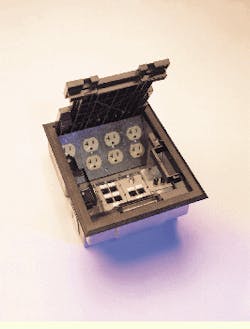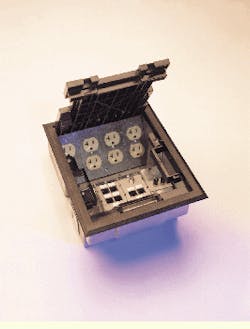Gail Leach Carvelli
Patrick McLaughlin
Bringing the necessary power, voice, data, and video cables to the workstation can be done many ways depending on a building`s design and the customer`s needs and specifications. Whether cables are run through the ceiling or the floor, they are usually terminated at a wall outlet. Raised floors, on the other hand, provide another termination option through access or raised-floor boxes.
According to Ken Hall, marketing manager for amp Inc.`s Netconnect Systems, these boxes "serve as an above-floor access to connection points for voice, data, and power applications. They provide complete wire management for this equipment." (See Product Update table, page 20.)
Raised floors are a welcome option for installations that include a large number of cables. Instead of running cables overhead, cables can be easily installed and rapidly changed under the raised flooring--which is why such floors are often found in a company`s computer or equipment room. "The decision to install a raised floor is usually computer-driven," says Mike O`Brien, product business manager for Walker Systems Inc., A Wiremold Co. "In a commercial building where there is a large amount of computer hardware, it generally translates into increased communications requirements." More requirements usually mean more cables.
But raised floors can also be used in the work area when additional cables are needed. "Many government buildings have raised floors in the work-place area because they have so many requirements. You`ll often see desk, after desk, after desk," says O`Brien. "Each person needs a place to plug his equipment into. He needs to be able to plug in his electrical devices, telephone lines, and computer equipment. A raised-floor box is a convenient way to make these connections."
But raised floors are often not practical in the general office area because of their expense. For example, O`Brien notes, in a new construction project, a raised floor on every floor would raise the height of the entire building, resulting in increased costs.
Karl Sandmann, a project manager for mts Services (Bedford, NH), also has reservations about floor boxes and how they stand up to physically demanding environments. "The floor box is a good solution in fixed environments, such as a conference room where a customer may like outlets in the center of the room," he says. "But in schools and hospitals, where there is a constant moving of tables and desks, and sliding of chairs, and kicking of feet, I have seen the modules that the patchcords are plugged into break or pop out of the box."
A useful connection point
Typically made of metal or plastic, usually with plastic comprising the trim material, access- or raised-floor boxes are recessed in the raised floor where they are placed. Boxes are also available for use in cement-slab floors.
Regardless of location, one of the key features of these boxes is their capacity. "There are raised-floor boxes on the market that barely give you enough capacity to install a phone jack and two duplex receptacles," notes Walker`s O`Brien. "Other boxes require that you choose whether you want power or communications capabilities in them. The main thing is to buy a box that provides enough outlets for the requirements of the workstation."
Most access- or raised-floor boxes, which can cost from $30 to more than $100, are designed to handle power cords that can also handle voice and data. "It is normal that you would provide those services to the workstation," says amp`s Hall, noting that there is usually one floor box per workstation. "It is more logical to have these cables in a single box for total cable management, because you don`t want to cut more holes in the floor panel than you need."
Installers must ensure that they are maintaining the structural integrity of the raised floor. "All floor boxes should be designed to exceed the load-bearing requirements of Underwriters` Laboratories (UL) and agency specifications, typically rated to the 300-pound roll test," Hall says, explaining that when a 300-pound object is rolled over the floor box, the box should not flex in any way.
Because of the various services housed within the box, a metal separator plate is necessary to divide the power from the communications receptacles--a requirement mandated by the National Electrical Code (nec). And UL specifications cover separation of power and communications circuits for low-voltage applications. If used in Canada, a floor box must meet the specifications of the Canadian Standards Association.
Floor boxes offer modularity
Like any modular outlet, floor boxes can handle nearly any type of cable, including unshielded twisted-pair, shielded twisted-pair, fiber-optic, coaxial, screened twisted-pair, and power cords. The customer`s applications dictate which outlets, or plates, to install. Most boxes are available in single- to five-gang configurations and can house up to 20 ports.
This also means that a client can ask that only power be brought to the floor box initially. Then, as communications requirements are determined, appropriate cables can be pulled from the telecommunications closet to the box. This modularity, says Hall, makes floor boxes an option for zone cabling or open-office environments.
Although the actual floor panels can often be moved with the floor box in place, Tim Murphy, vice president for Apex Communications (Sunnyvale, CA), says that can be inconvenient. "With all the moves, adds, and changes that take place," he notes, "having to reconfigure the flooring can take considerable time."
Floor-box specifications
Installers need to know what size floor box they will need because dimensions can range from 21/2 x 10 x 8 inches to 12 x 10 x 55/8 inches. Some floor boxes are also available in round configurations. Installers must also know what kind of door or lid is required. Some manufacturers make boxes that have a hinged door, while others have a lid that lifts off the box. One advantage of hinged doors is that they lock open while the technician is working inside. One manufacturer takes that idea a step further: When the door is opened, the outlets inside the box are raised above the floor, making them easier to access.
Another consideration is the lid material. Some lids can be covered with the same carpeting material that is being used in the work area so that the aesthetics of the office are unchanged.
Installers can also suggest precabled floors boxes with a flexible system. "This allows you to use the floor box as a plug-and-play unit," says Walker`s O`Brien. "Basically all you are doing is plugging into a distribution unit somewhere down the line, which is hardwired. Then, you take the other end of that flexible unit and plug it into the box."
The AF Series of raised-floor boxes from Walker Systems Inc. includes three separate compartments for power or communications devices.
When the door is opened, the outlets inside the Access Floor Workstation Module from amp Inc. are raised above the floor for easier access. When the door is closed, the outlets recede into the box.


